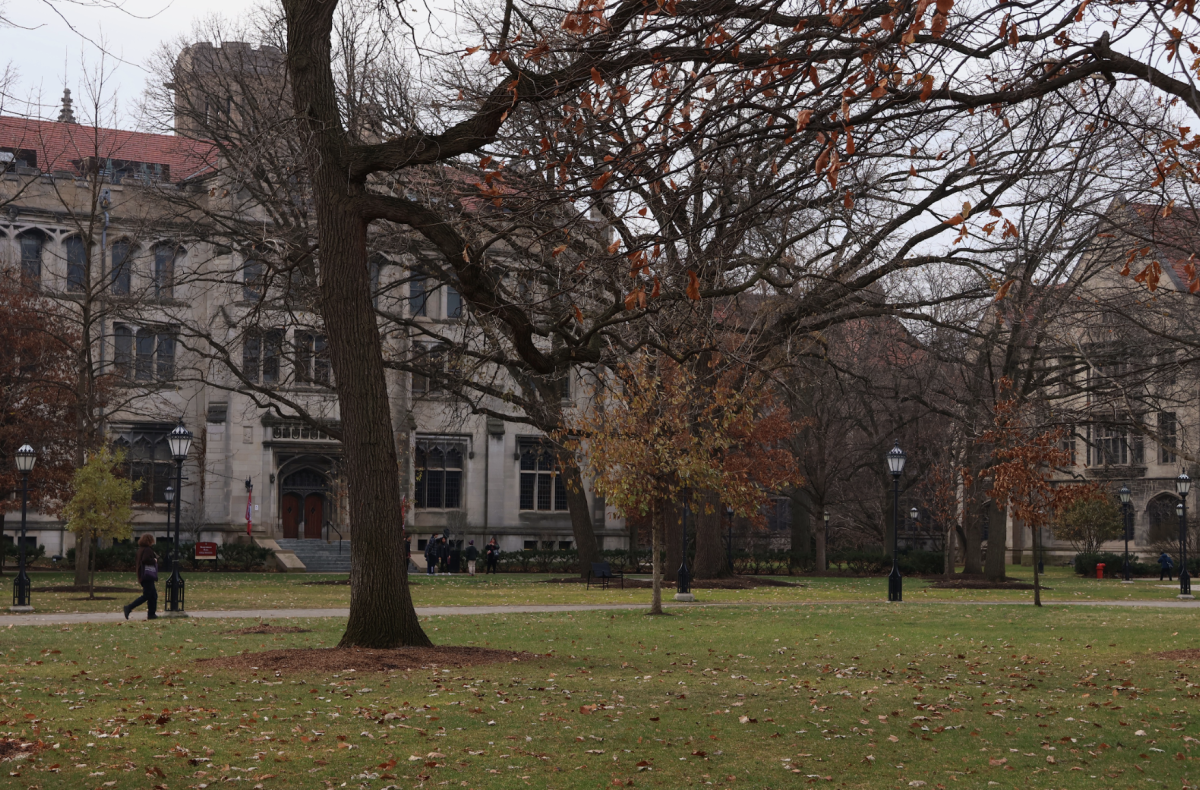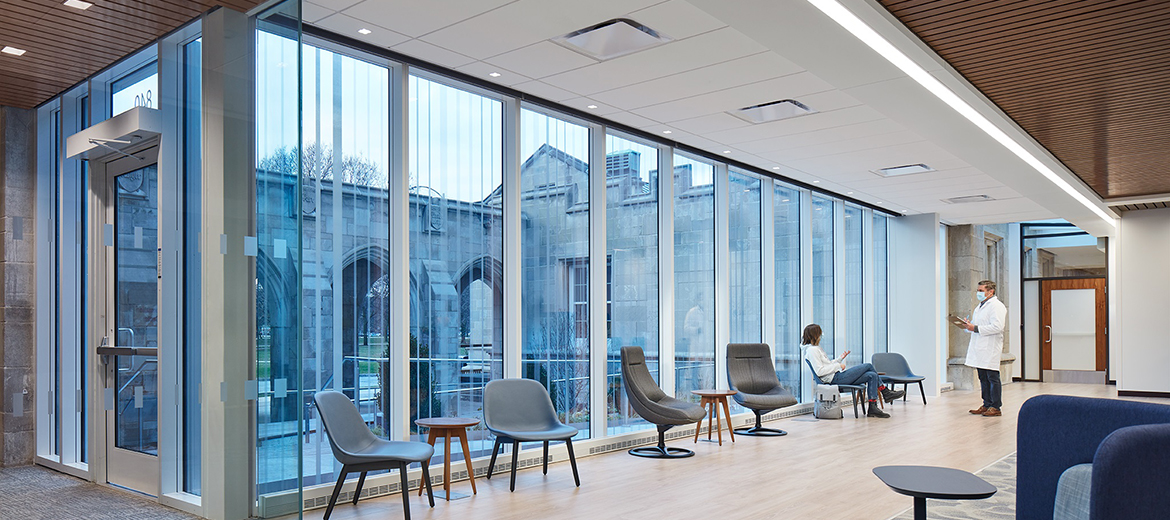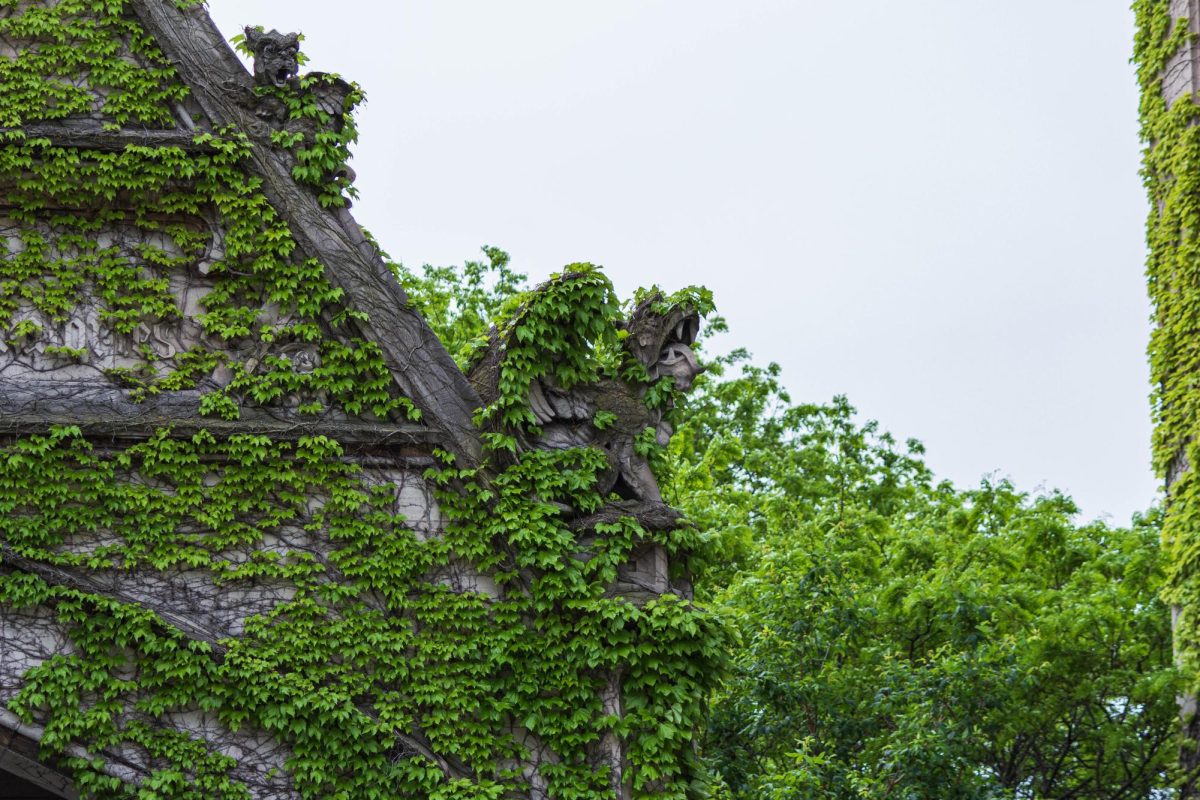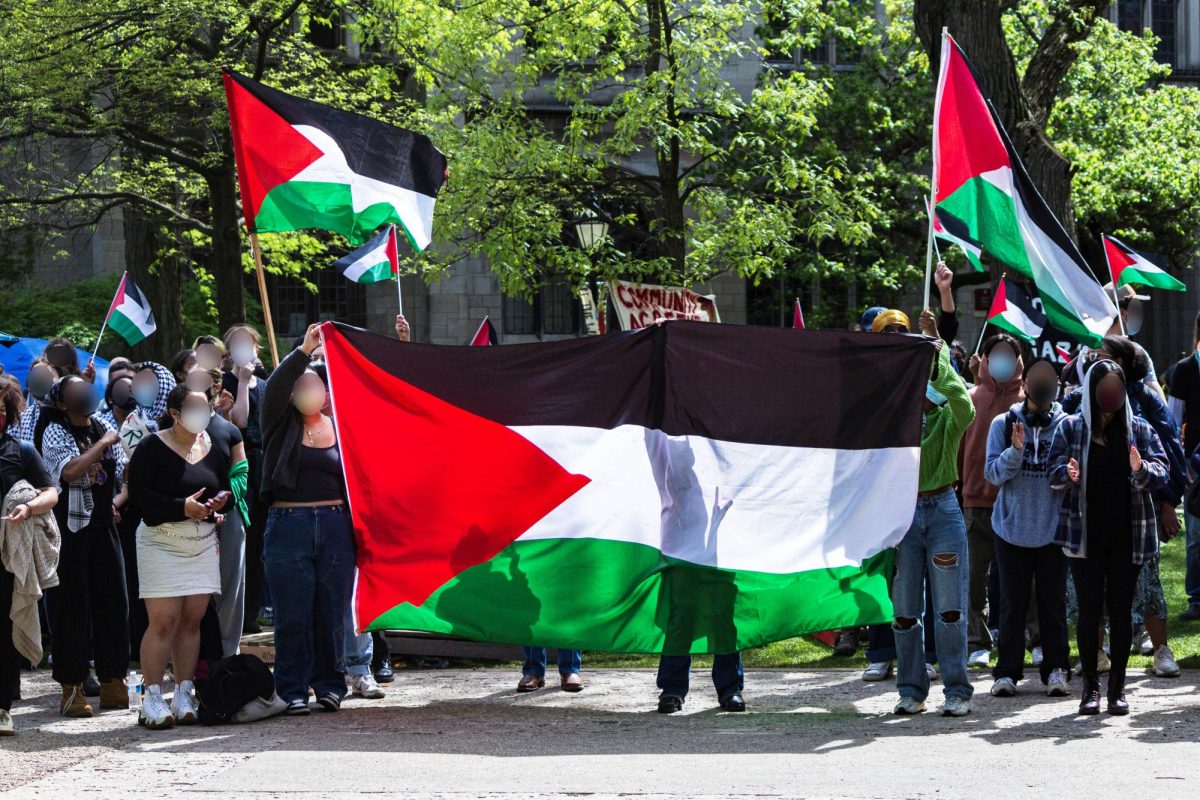So you’ve gotten your Elvis smoothie and veggie bagel at Robust on 63rd and Woodlawn, sent some emails to professors, and stepped back out onto the street. Half of your smoothie still waits for consumption on the way back to your dorm. But as you start walking, something catches your eye: possibly the largest vacant lot you’ve ever seen, stretching west along 63rd Street. There must have been buildings here once, you think, because this hole in the streetscape exposes the backsides of nearby apartments—brick, three stories high—like body parts that should never have seen the sun. Occasionally, other pedestrians pass, accompanied by the sound of crickets, which hide between the Styrofoam cups in the grass. The Obama Center’s bulldozers rumble at 63rd Street’s eastern terminus in Jackson Park. The strongest feeling here is emptiness.
It’s a different story at Cottage Grove Avenue, half a mile west of Woodlawn. Here, 63rd Street comes alive, rumbling like the El tracks that start overhead. At a Mobil station, friends holler at each other from their cars. A relic of a man in wingtip shoes and a fedora leans into the street as if hailing a cab, while an odd youth who’s seen one too many horror movies walks by with stuffed monsters dangling from his belt. At Daley’s Restaurant—the oldest restaurant in Chicago—patrons hold summits about their sons and daughters and uncles and cousins over sweating cups of ice water, pork chops, and eggs over-easy. The faded neoclassical facade of Washington Park National Bank hides behind scaffolding and screeching train tracks. Girls pull away from their boasting classmates at the crosswalks with winking I’ll-see-you-tomorrows and unspoken aw-don’t-go-yets. Two new buildings rise skyward, one complete and one in progress.
These two spots reveal something about 63rd Street. Ever since disinvestment, arson, and population decline gutted this onetime commercial artery of the Woodlawn neighborhood, it’s been mostly empty, lacking new development in its huge vacant lots. But its community has endured, clearly evident in the bustle of 63rd and Cottage Grove. Now, as the UChicago-sponsored Obama Center directs the attention of real estate developers to the area, 63rd is seeing new construction, a rebirth up and down the street. But who benefits? The resilient community, or the UChicago student walking from Robust? Only 63rd Street’s past can tell us who the street belongs to.
If you talk to anyone who grew up in the neighborhood before about 1970, 63rd will begin to glow with a child’s memories of a Black economic and cultural heyday. You didn’t need to go downtown, they say. On the street, you could find everything from pastry shops to curtain cleaners, pool halls to bookstores, flower shops, fishmongers, gilded department stores, one chop suey joint, a Greyhound bus station, and a whole lot of beauty salons. Movies flickered and music swelled at the Maryland Theater, on the site of today’s three-block-long vacant lot. A group of old ladies always sat outside the library at 62nd and Kimbark, watching, ready to tell on you to your parents. Sultan Mahmood, the barber, did natural haircuts in a shop plastered with Ebony and Jet magazine covers. One man remembers ogling Muhammad Ali’s car parked outside his training gym at 63rd and Cottage Grove and catching glances of Willie Mays and Minnie Miñoso at the Evans Hotel, where Black MLB players stayed during away games in a segregated city. Another recalls dancing for spare change with his friends outside the street’s taverns. One woman told me about her elementary school best friend, a member of 63rd’s tiny Chinese enclave between Woodlawn and Kimbark, who taught her to embroider. She still keeps her friend’s perfect exemplar at home, with her own, clumsier attempt beside it.
And if you couldn’t see the stars at night for all the steel mill smoke, on 63rd, they came out at lounges, restaurants, and clubs. At the Pershing Hotel, steps from today’s Green Line terminus at Cottage Grove, Ahmad Jamal recorded his famous song “Poinciana,” twinkling like the audience’s champagne and crystal. Well-heeled couples could walk from their homes to jazz clubs like the Trianon and the 411, while anxious first-date lovers crowded into the peanut galleries meant for underage viewers. At 63rd and South Park (now King Drive), Sun Ra and his Arkestra accompanied drag shows at Queen’s Mansion while national touring acts like Sam Cooke performed at the flashy Roberts Motel. Up and down the street, cymbals skated along to horn-sharp punctures and walking bass, cabaret dancers kicked in unison, and electric blues snarled from the street’s rougher corners. It felt as if the night would never end. But closing time always came, with its staggering walks home, a few last notes hanging in the cigarette smoke, and upstairs lace curtains flapping in the breeze as the train rumbled overhead like a lullaby.
UChicago’s decision-makers wanted nothing to do with this scene. In a 1961 address to the Board of Trustees laying out his controversial urban renewal program, University administrator Julian Levi painted a different picture of 63rd Street and its surrounding Woodlawn neighborhood: “social disorganization, community collapse, and consequent crime, utterly incompatible with the existence of a great university.”
Where locals saw home, Levi saw a threat. Once populated by professors and students, Woodlawn had experienced a transition from 85 percent white to 85 percent Black in the 11 years before Levi’s speech, according to documents from the University’s archives. Migrants from Southern states, many struggling to find work, lived in crowded, substandard housing. The Blackstone Rangers street gang—famous for trading in both illegal drugs and Black nationalist ideology—grew stronger. To the leadership of the majority-white University, Woodlawn was a fate to be avoided. So when Levi proposed a slew of redevelopment projects aimed at making Hyde Park an “interracial community of high standards,” the Board assented, making our neighborhood a model for elite urban universities grappling with suburbanization and white flight.
The University’s plans didn’t completely ignore Woodlawn. There had been a proposal to raze all housing north of 63rd for an enlarged South Campus and an idea by famous modernist architect Eero Saarinen to bury 63rd Street under a new interstate highway spur. Neither were carried out by University administrators or their allies in government; more than those scrapped plans, it was Levi’s attitude towards our southern neighbor that left a lasting legacy. For generations of UChicago students and faculty, Woodlawn came to be defined by Levi’s words—“social disorganization” and “community collapse”—words that negate a community entirely, making it into some shadowy morass that could never be someone’s home. Images of gang rule and dangerous crack addicts stuck in the minds of students hunched over books in faux Gothic cathedrals less than a mile away.
Meanwhile, drug dealing, a wave of arsons, and a declining population dealt a blow to the street’s small businesses in the ’70s and ’80s. Chicago’s aggressive demolition policy in the 1990s cleared the vacant storefronts for good. The city’s abrupt 1997 demolition of the Green Line east of Cottage Grove—it once stopped at University, Dorchester, and Jackson Park—depressed foot traffic, driving out a few resilient family businesses. Some people in Woodlawn maintain that UChicago used these conditions to buy up large swaths of vacant land for cheap. Another popular theory even claims that the University paid the Blackstone Rangers gang to engineer this process, setting fires and roughing up 63rd. It’s near impossible to verify these claims in archives (this article’s author has tried), but their continued resonance points to the hostility with which UChicago’s leaders approached Woodlawn in those days. It’s a hostility that contributed to a level of racial segregation usually associated with the Jim Crow South, not with the backyard of an intellectual powerhouse and its supposedly enlightened inhabitants.
Today, UChicago’s attitude toward Woodlawn is changing. Recent University administrations have encouraged students to break the invisible wall between Hyde Park and Woodlawn with initiatives in the Office of Community Engagement. Students living in private apartments began to tiptoe south of the Midway, attracted by lower prices. Robust Coffee Lounge, popular with students, opened. UChicago built a charter school at 63rd and Greenwood, and the new Hyde Park Day School, a school for students with learning disabilities with ties to UChicago, opened across the street. When Jackson Park was announced as the site of the UChicago-backed Obama Presidential Center in 2016, housing prices in the neighborhood jumped. Since then, million-dollar homes explicitly marketed toward UChicago professors have gone up. Big glassy developments are replacing vacant lots and run-down storefronts, each one promising to bring back a street life vibrancy unseen in decades, with environmental sustainability and racial equity to boot. Unsurprisingly, according to census records, Woodlawn’s white population has grown by almost 50 percent in the last 14 years. Newspaper articles, UChicago spokespeople, and real estate marketing materials laud the neighborhood’s rebirth.
Living in our mixed-use, transit-oriented, walkable age, it’s only natural to dream of restoring 63rd Street to its former glory. Some UChicago circles genuinely do so: A research team of students in the Chicago Studies program recently completed a yearlong project mapping the business history of 63rd Street, block by block. UChicago’s Arts & Public Life initiative does similar work, holding events like 2023’s “Body & Soul: Recovering Community Stories from South Side Music Venues.”
“Imagine this is a juke joint,” one of the event’s organizers said as veteran jazz guitarist George Freeman took the stage in the new Green Line Performing Arts Center on East 55th Street, which, like 63rd, has a history of Black nightlife and commercial activity.
Mapping and imagining is different from building, but it’s hard not to see the connection in last year’s Woodlawn Community Summit, a UChicago-hosted forum of local developers and political hopefuls that prophesied the rebirth of 63rd as a “full-fledged main street.” Already, 63rd and Cottage Grove is a node of condos and storefronts, not the open-air drug market people remember from only 20 years ago. Through the optimism of the city, UChicago, and the Obama Center, one big question is implied: could 63rd Street become a laboratory for a better kind of urban revitalization, one that’s people-focused, sustainable, and fair?
For a possible answer, go back to the intersection of 63rd and Woodlawn, to the row of suburban-style homes beside Robust. Officially named “Columbia Pointe,” these homes were built in the mid-2000s by the real estate arm of The Woodlawn Organization (TWO). Founded by Bishop Arthur Brazier in the 1960s to protest UChicago’s South Campus plans, TWO grew to be one of the first modern community organizations and operated under the credo of “Black self-determination.” Its legacy in the neighborhood is controversial—many fault Brazier’s church for lobbying the city to demolish the El’s eastern spur, and the federal government took over one of TWO’s low-income housing developments in 1986 after 17 years of embezzlement and neglected maintenance. But TWO’s later developments still provide affordable and market-rate housing today, complicating the narrative that Woodlawn has been waiting for redevelopment until UChicago and its gaggle of allied developers came to save the day.
Saul Alinsky, the legendary community organizer, was one of TWO’s advisors when it was first founded. “For Alinsky, the first task is to beat down the mythologies which have maintained ghetto dependency,” John Hall Fish wrote in Black Power/White Control, his history of the period. “Specifically, to beat down the ‘medical’ interpretation of ghetto problems, an interpretation which legitimates outside control.” By “medical,” Alinsky meant the narrative that diagnoses Woodlawn with a social illness and prescribes a solution to be administered by an authority figure. He contrasted that narrative with a “political” interpretation, where the issue was not Woodlawn’s troubled condition, but its powerlessness in decision-making. Alinsky’s words are as relevant as ever: today’s “medical” narrative sees 63rd Street as a patient waiting to be helped by experts, like a neighboring university dreaming and prescribing new futures for it. In the political interpretation, 63rd is territory that Woodlawn’s watchful and organized residents have always owned and intend to keep for themselves.
A low-slung storefront a couple of blocks off 63rd is the headquarters of an organization called Southside Together Organizing for Power (STOP). I spoke to its interim director Alex Goldenberg while he sipped coffee on the sidewalk outside his office. He explained to me the group’s origins: in 2004, new UChicago plans for expanding South Campus raised fears that the Grove Parc housing project—located along South Cottage Grove Avenue—would be converted to new University facilities or unaffordable, market-rate condos. A group of Grove Parc tenants and University students organized together to avoid this fate. They wrangled with University and federal officials until they achieved a sale of the property to Preservation of Affordable Housing (POAH), a non-profit affordable housing developer.
By the mid-2010s, POAH had built new affordable housing all along the former Grove Parc strip, and the organization that emerged from the struggle, now called STOP, had moved on to another issue: a binding community benefits agreement with the newly announced Obama Center, which would legally compel Obama’s foundation to ensure funding for community needs identified by STOP. The coalition led by STOP could not get the Obama Foundation to budge from its stance against an agreement, ironic for an ex-community organizer president. Instead, aided by friendly alderman Jeanette Taylor’s election to City Council in 2019, many of the proposed measures were made into law by the city’s Woodlawn Housing Preservation Ordinance the next year.
This was a win for STOP, but only an ephemeral one. Among other things, the new law required that a quarter of Woodlawn’s vacant land be “reserved” for affordable housing, defined as buildings where one third of units are affordable to households earning 30 percent to 50 percent of Chicago’s Area Median Income, or about $45,000 for a family of four. The trouble began when city officials had to choose these unspecified “reserved lots”: small lots in a side street counted equally to larger ones on 63rd. So while then mayor Lori Lightfoot praised the law for “ensuring that every neighborhood resident is able to stay in their homes and share the transformative promise by the Obama Presidential Center,” the city stalled and avoided “reserving” large lots on 63rd.
Fearing that without pressure, the city would only “reserve” small lots where a five-unit building yields one affordable apartment, STOP immediately started pressuring the city to reserve larger lots, where twenty-unit buildings could fit six affordable apartments. They used creative tactics, such as sending Lightfoot heart-shaped Valentine’s cards with captions like: “Be my Valentine and stop displacing Black families.” Gradually, the city acquiesced to STOP’s demands. Some of the new construction on the street is located on these affordable lots. But it’s an uphill battle at best. Even if STOP successfully wins affordable status for every large vacant lot on 63rd, they expect these developments to retain only about a fifth of the 10,000 people the city estimates will be displaced from Woodlawn in coming years by rising prices. On 63rd Street, it seems that development is a deal with the devil, with thousands of priced-out Woodlawn natives bearing the cost. Indeed, there is a rebirth going on—but not for them.
One Saturday morning, I attended a canvassing day at STOP, aimed at convincing residents to attend an upcoming public forum with Alderman Desmon Yancy and hold him to his promise of designating one particularly large vacant lot near the Obama Center as affordable. In the tiny 61st Street office with orange walls, the phone bankers learn how to cold-call constituents effectively. They are all elderly Black women. Judging from their conversations over free scrambled eggs and pancakes, many seem to know each other already. They manage to kick the too-loud younger crowd, who have come to knock on doors and hand out flyers, out of the office. I head out in a trio led by housing organizer Savannah Brown, a calm, authoritative young woman who joined STOP after the George Floyd protests. She is joined by a no-nonsense retired schoolteacher and a soft-spoken younger woman whose t-shirt refers to Jesus. We go door-knocking at a co-op development so close to the Obama Center that workers’ shouts are audible. The canvassing sees success, and Brown’s group gets many residents to consider attending the forum.
I quickly realized that canvassing has a deeper significance: it lets one collect the voices and feelings of a neighborhood. An elderly gentleman tells us he can’t spread the word about the forum because neighbors don’t talk to each other the way they used to; one girl says she would talk to us, but can’t, because she’s rushing to get her nails done for prom. A young woman tells us that co-op residents can’t barbecue in Jackson Park anymore because of policing around the construction site. Two men seem to have adapted; they barbecue on the street outside the co-op. A young man introduces us to his cat, and a grandmother speaks with us while her grandkids peek from behind her skirt. A high schooler, coincidentally a youth volunteer for STOP, bounces down the street on the way to an event he organized to keep his classmates out of trouble during the long Memorial Day weekend.
Some people clearly undergo an emotional change when they hear about STOP’s work. When Brown approaches a young mother wearily dragging her unruly son down the street, the woman’s jaw is set and her eyes are narrowed, just listening to be polite. But as Brown explains what exactly STOP does, the woman’s facial features loosen, seemingly touched by the organization’s work on an issue that has worried her, too.
When we return to the office, it seems that the emotional change is reciprocal: during the post-canvassing reflection, it’s hard to pinpoint exactly what made some conversations special, but most of the volunteers try anyway. Maybe it’s somebody who was about to turn away but didn’t, somebody who did not believe in change, then suddenly did. They recount these meetings with a certain wonder in their voices, a wonder that, to me, seems like the main reward of the day. It’s the subtle clarity of stepping outside yourself and the stories you inhabit to listen to somebody else. It’s claiming to know, then not knowing; it’s thinking you’re the only one, then seeing there are more. The feeling floats up to the ceiling of the little orange-walled office and lingers like a cloud above the volunteers as they begin to plan what’s next.
















